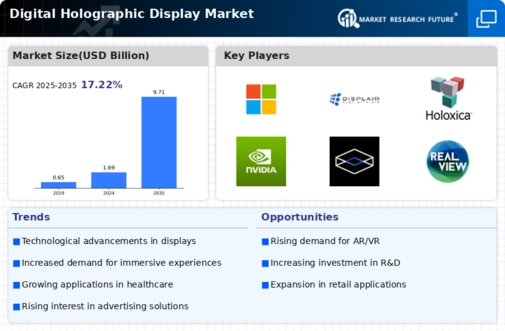Rising Demand for Immersive Experiences
The Digital Holographic Display Market is witnessing a notable surge in demand for immersive experiences across various sectors. As consumers increasingly seek engaging and interactive content, businesses are compelled to adopt advanced display technologies. This trend is particularly evident in entertainment and advertising, where holographic displays provide a unique way to capture audience attention. According to recent estimates, the market for immersive technologies is projected to grow significantly, with holographic displays playing a pivotal role. Companies are investing in research and development to enhance the quality and accessibility of these displays, indicating a robust growth trajectory for the Digital Holographic Display Market.
Expansion of Retail and E-commerce Sectors
The expansion of retail and e-commerce sectors is significantly influencing the Digital Holographic Display Market. As retailers seek to differentiate themselves in a competitive landscape, holographic displays offer a unique solution to enhance customer engagement. These displays can be utilized for virtual try-ons, product demonstrations, and interactive advertisements, thereby enriching the shopping experience. Recent market analyses suggest that the integration of holographic technology in retail environments is likely to increase, as businesses aim to attract tech-savvy consumers. This trend indicates a growing opportunity for the Digital Holographic Display Market to cater to the evolving needs of the retail sector.
Increased Focus on Training and Simulation
The Digital Holographic Display Market is benefiting from an increased focus on training and simulation applications. Industries such as defense, aviation, and healthcare are leveraging holographic displays to create realistic training environments. These displays facilitate immersive learning experiences, allowing trainees to interact with 3D models and scenarios. The effectiveness of holographic training solutions is becoming increasingly recognized, leading to higher adoption rates. Market Research Future indicates that the demand for such training tools is expected to rise, further propelling the growth of the Digital Holographic Display Market. This trend underscores the potential of holographic technology in enhancing educational and professional training outcomes.
Growing Investment in Advertising and Marketing
The Digital Holographic Display Market is experiencing a surge in investment from advertising and marketing sectors. Companies are recognizing the potential of holographic displays to create memorable brand experiences and engage consumers in innovative ways. This trend is reflected in the increasing number of campaigns utilizing holographic technology to showcase products and services. Market data indicates that the advertising industry is projected to allocate a larger portion of its budget towards immersive technologies, including holographic displays. This shift not only enhances brand visibility but also drives the demand for advanced display solutions within the Digital Holographic Display Market.
Technological Advancements in Display Technologies
Technological advancements are driving the evolution of the Digital Holographic Display Market. Innovations in optics, materials, and processing techniques are enabling the creation of more sophisticated holographic displays. These advancements not only improve image quality but also reduce production costs, making holographic displays more accessible to a wider range of industries. For instance, the introduction of new light modulation technologies has enhanced the resolution and brightness of holographic images. As a result, sectors such as retail and automotive are increasingly adopting these displays for marketing and product visualization. The ongoing research in this field suggests a promising future for the Digital Holographic Display Market.

















Leave a Comment